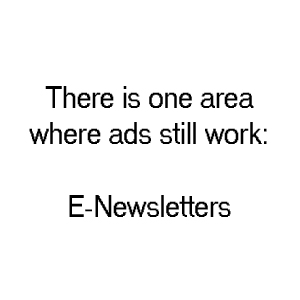 One of the great mysteries in online marketing and advertising is the fact that an overwhelming majority of consumers no longer trust ads, yet businesses still rely too much on conventional ads that consumers will either refuse to believe or just outright block for being too annoying. Marketers still do find some semblance of success with traditional online ads, but this only works through sheer volume, and requires amounts of resources that is practically unavailable to small businesses with limited advertising budgets. Thankfully, there is one area where ads still work: E-Newsletters.
One of the great mysteries in online marketing and advertising is the fact that an overwhelming majority of consumers no longer trust ads, yet businesses still rely too much on conventional ads that consumers will either refuse to believe or just outright block for being too annoying. Marketers still do find some semblance of success with traditional online ads, but this only works through sheer volume, and requires amounts of resources that is practically unavailable to small businesses with limited advertising budgets. Thankfully, there is one area where ads still work: E-Newsletters.
Why Traditional Ads No Longer Work, and Why Ads on E-Newsletters Still Do
Contrary to what two-bit marketers would have you believe, consumers these days are better informed and less likely to see any advertisement as anything but a blatant attempt to part them with their money. Information, comparison, and alternatives are all a mouseclick away these days, so it’s extremely difficult to get people to respond positively to an ad, especially if the product it is advertising is mediocre or sub-par.
Ads on E-newsletters, on the other hand, still work better than conventional ads due to a number of factors that are present only on the medium, such as:
1. E-Newsletters Are Founded on Trust and Permission – unlike websites, recipients of e-newsletters are well aware of what content they will receive and when, and they have given their express permission to the sender. This means there is less likelihood that your ads won’t be seen as a nuisance, but accepted as part of the package they are getting with the service.
2. Ads on E-Newsletters Are Highly Targeted – while websites do allow you to target visitors based on the topic of the website and what cookies manage to glean out of the users, e-newsletters are unparalleled in their capability to accurately target demographics – during opt-in, businesses can already categorize and segment their lists with pinpoint accuracy. Additionally, do you think websites can serve custom copies of the website content to visitors in real time based on their personal profiles? E-newsletters can, and it doesn’t require exceptional coding skills or above average technical know-how. Email service providers already allow this capability by default.
3. Communication is Much More Personal – marketers worth their salt know that the most effective form of advertisements are those that speak to a consumer on a personal level. Websites can’t do this, at least not with their ads. To consumers, even the most personal of websites are still emancipated from the ads that are running on it. The ads are therefore wholly ignored. With e-newsletters, on the other hand, the ads can be run in a way that seamlessly integrates it with the content, making it more of a personal recommendation than an attempt to sell something.
4. E-Mail Makes it Easier for Things to Spread – lastly, it has to do with that magic word that marketers love so much: “Viral.” While there’s no 100% way to make anything go viral, the medium of e-newsletters makes it that much easier for things to go viral – simply because of the perfect confluence of various factors; a person who loved a newsletter so much only needs to click a single button to forward it to ALL of his friends, all of which have the potential to repeat the process. Next, people who receive the forwarded mail have no choice but to at least skim it if it was sent by a friend, whereas a forwarded URL will usually be ignored if the recipient is “not in the mood.”
At the end of the day, an e-newsletter will not replace a website when it comes to e-commerce and vice versa. However, if you want your ads to reach its maximum potential, it would be foolish not to start an e-newsletter for your brand, product, or company.












Pingback: How to Use Newsletter for Retargeting | www.admailr.com
Pingback: Admailr and Emercury Can Help You Build Your Brand Digitally | www.admailr.com
Pingback: Why People Shop Online and How Your Newsletter Can Benefit | Admailr